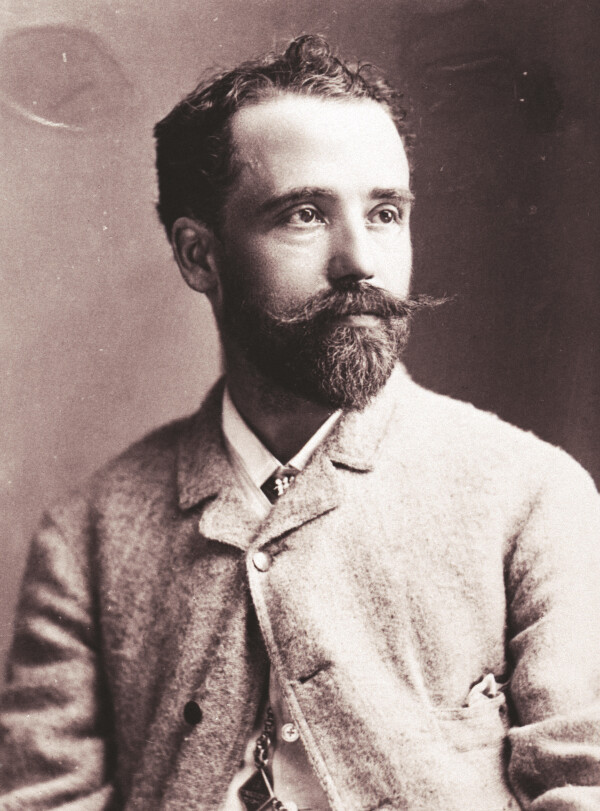Julius Victor Berger

Julius Victor Berger, Künstlerhaus Archive, Vienna
© Künstlerhaus-Archiv, Vienna
Julius Victor Berger taught decorative painting at the Vienna School of Arts and Crafts. His students included Gustav Klimt, Ernst Klimt and Franz Matsch, who together executed his designs at Zierer Palace and at the Hermesvilla. One of his best-known works is the ceiling painting Patronage of the Arts by the House of Habsburg at the Kunsthistorisches Museum.
The painter Julius Victor Berger was born in Neutitschein, Moravia (now Nový Jičín, Czech Republic) in 1850. He studied at the Vienna Academy of Fine Arts for ten years from 1864. After he had completed his studies, he received a travel grant and spent several years in Italy.
Teacher and Patron of the “Künstler-Compagnie”
Berger became a teacher at the Vienna School of Arts and Crafts of the Austrian Museum of Art and Industry in 1881. He took over the Decorative Painting Class of the recently deceased Ferdinand Laufberger. His students included Gustav Klimt, Ernst Klimt and Franz Matsch. After they had completed their studies, the young artists – known henceforth as the “Künstler-Compagnie” – executed artistic decorations based on the sketches and designs of their former teacher at Zierer Palace (1881/82, later Kranz Palace) and in the bedroom of the Hermesvilla (1885). In 1887, Berger stopped teaching at the School of Arts and Crafts and became a professor at the Academy of Fine Arts, where he continued to teach until his death in 1902.
Berger’s Oeuvre
Berger’s artistic oeuvre comprises many history and genre paintings, portraits, illustrations, drawings, graphic works and interior decorations for private houses and public buildings, such as the ceiling frescoes at the Justizpalast in Vienna. One of his most famous works is the monumental ceiling painting Patronage of the Arts by the House of Habsburg (1891) in the Golden Hall of the Imperial-Royal Court Museum (now Kunsthistorisches Museum).
Literature and sources
- Österreichische Illustrierte Zeitung, 23.11.1902, S. 153.
- Österreichische Kunst-Chronik, Nummer 7 (1888), S. 170-172.
- Neues Wiener Tagblatt, 24.07.1891, S. 4.
- Österreichische Akademie der Wissenschaften (Hg.): Österreichisches Biographisches Lexikon 1815–1950, Band 1, Vienna 1994.
- Felix Czeike (Hg.): Historisches Lexikon Wien, Band 1, Vienna 1992, S. 330.
- Beatrix Kriller-Erdrich: Julius Victor Berger und die Mäzene des Hauses Habsburg. Ein Bilddenkmal zur Entstehungsgeschichte der habsburgischen Sammlungen, Vienna 2006.
- Günter Meißner, Klaus Gerhard Saur (Hg.): Allgemeines Künstler-Lexikon. Die bildenden Künstler aller Zeiten und Völker, Band IX, Munich - Leipzig 1994, S. 357-358.
- Ulrich Thieme, Felix Becker (Hg.): Allgemeines Lexikon der Bildenden Künstler von der Antike bis zur Gegenwart. Begründet von Ulrich Thieme und Felix Becker, Band III, Leipzig 1909, S. 397-398.
- Kunsthandlung C. J. Wawra (Hg.): 181. Kunstauktion. Versteigerung der Ölgemälde, Aquarelle, Handzeichnungen, Bücher und Dekorationsgegenstände: aus dem Nachlasse des Historienmalers Julius Berger, Aukt.-Kat., Vienna 1903.
- Otmar Rychlik (Hg.): Gustav Klimts Lehrer. 1876-1882. Sieben Jahre an der Kunstgewerbeschule, Ausst.-Kat., MAK - Museum of Applied Arts (Vienna), 03.11.2021–13.03.2022, Bad Vöslau 2021, S. 119-122.

